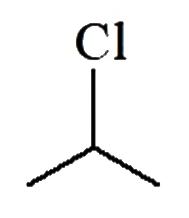Propene on reaction with hypochlorous acid gives ?




The correct Answer is:A
To determine the product formed when propene reacts with hypochlorous acid, we can follow these steps:
Step 1: Identify the Reactants
- Propene: The chemical formula for propene is C3H6, which can be represented as CH3CH=CH2.
- Hypochlorous Acid: The chemical formula for hypochlorous acid is HOCl.
Step 2: Understand the Reaction Mechanism
- The reaction of propene with hypochlorous acid will follow Markovnikov's Rule. This rule states that when HX (where X is a halogen or similar group) adds to an alkene, the hydrogen atom (H) will attach to the carbon with the greater number of hydrogen atoms, while the halogen (or OH group in this case) will attach to the carbon with fewer hydrogen atoms.
Step 3: Analyze the Double Bond in Propene
- In propene, the double bond is between the first and second carbon atoms:
- C1: CH3 (attached to 2 hydrogens)
- C2: CH (attached to 1 hydrogen)
- C3: CH2 (attached to 2 hydrogens)
According to Markovnikov's Rule, the negative part of hypochlorous acid (the hydroxyl group, -OH) will attach to the carbon with fewer hydrogens, which is C2.
Step 4: Determine the Product
- The positive part of hypochlorous acid (the chlorine, Cl) will attach to the carbon with more hydrogens, which is C1.
- Therefore, the product formed will be:
CH3C(OH)CH2Cl
- This can also be written as:
CH3CH(OH)CH2Cl
Step 5: Final Product Representation
- The final product of the reaction between propene and hypochlorous acid is:
2-chloropropan-1-ol
- Propene: The chemical formula for propene is C3H6, which can be represented as CH3CH=CH2.
- Hypochlorous Acid: The chemical formula for hypochlorous acid is HOCl.
- The reaction of propene with hypochlorous acid will follow Markovnikov's Rule. This rule states that when HX (where X is a halogen or similar group) adds to an alkene, the hydrogen atom (H) will attach to the carbon with the greater number of hydrogen atoms, while the halogen (or OH group in this case) will attach to the carbon with fewer hydrogen atoms.
- In propene, the double bond is between the first and second carbon atoms:
- C1: CH3 (attached to 2 hydrogens)
- C2: CH (attached to 1 hydrogen)
- C3: CH2 (attached to 2 hydrogens)
- The positive part of hypochlorous acid (the chlorine, Cl) will attach to the carbon with more hydrogens, which is C1.
- Therefore, the product formed will be:
CH3C(OH)CH2Cl
- This can also be written as:
CH3CH(OH)CH2Cl
- The final product of the reaction between propene and hypochlorous acid is:
2-chloropropan-1-ol
Similar Questions
Knowledge Check
What products are expected from the disproportionation reaction of hypochlorous acid ?
AHClO3 and Cl2OBHClO2 and HClO4CHCl and Cl2ODHCl and HClO3
What change will occur for the following reaction if the hypochlorous acid solution is diluted from 0.1 to 0.01 M?
HOCl(aq.)+H2O(l)⇔OCl−(aq.)+H3O+(aq.)
View SolutionThe compound which on reaction with cold nitrous acid gives oily nitrosoamine is
View SolutionCane sugar on reaction with nitric acid gives
View SolutionWhat happens when acetylene is treated with hypochlorous acid
View SolutionPropene to propanone
View SolutionThe oxidation state of chlorine atom in hypochlorous acid is
View SolutionAcid anhydrides on reaction with primary amine gives…
View Solution
